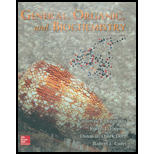
Concept explainers
(a)
Interpretation:
Given reaction is exothermic or endothermic has to be identified.
(a)
Explanation of Solution
Given reaction is,
From the given equation, it is understood that heat energy is released. Therefore, this is an exothermic reaction. Heat is released to the surroundings.
(b)
Interpretation:
Sign of enthalpy of the given reaction has to be identified.
(b)
Explanation of Solution
Given reaction is,
The reaction given is found to be an exothermic reaction. This means the enthalpy of reactants will be less than that of product. Therefore, enthalpy of the reaction will be negative.
(c)
Interpretation:
Meaning and significance of enthalpy has to be given.
(c)
Explanation of Solution
Given reaction is,
The reaction given is found to be an exothermic reaction. This means the enthalpy of reactants will be less than that of product. Therefore, enthalpy of the reaction will be negative. Enthalpy is the term that is used to represent heat. The sign of enthalpy gives information that the reaction is exothermic or endothermic.
(d)
Interpretation:
Sign of entropy of the given reaction has to be identified.
(d)
Explanation of Solution
Given reaction is,
Entropy is the measure of randomness or disorder in a system. Physical state of the reactant and product are gas only. Therefore, there will not be any change in entropy.
(e)
Interpretation:
Meaning and significance of entropy has to be given.
(e)
Explanation of Solution
Given reaction is,
Entropy is the measure of randomness or disorder in a system. Physical state of the reactant and product are gas. Therefore, there is no change in entropy. This means the reaction is completely dependent on enthalpy.
(f)
Interpretation:
The reaction given will be spontaneous or nonspontaneous has to be identified.
(f)
Explanation of Solution
Given reaction is,
It is known that change in enthalpy of the reaction is negative. This means the reaction is exothermic. Therefore, the given reaction is nonspontaneous because change in entropy is zero.
(g)
Interpretation:
Reaction will be slow or fast if the rate constant of the reaction is small has to be predicted.
(g)
Explanation of Solution
Given reaction is,
Larger rate constant value means the reaction will be relatively fast. This is because the concentration of the reactant will be more and there will be increased collision. As the rate constant given for the reaction is small, the reaction will be slow one.
(h)
Interpretation:
One strategy for increasing the
(h)
Explanation of Solution
Given reaction is,
Given reaction is an exothermic reaction. Decreasing the temperature may increase the rate of the reaction. Other possibility is to increase the pressure. As per LeChatelier’s principle, increasing the pressure results in shifting of equilibrium towards fewer moles of gas. Therefore, the rate of this reaction is increased.
Want to see more full solutions like this?
Chapter 7 Solutions
GENERAL,ORGANIC,+BIOCHEM.(LL) >CUSTOM<
 ChemistryChemistryISBN:9781305957404Author:Steven S. Zumdahl, Susan A. Zumdahl, Donald J. DeCostePublisher:Cengage Learning
ChemistryChemistryISBN:9781305957404Author:Steven S. Zumdahl, Susan A. Zumdahl, Donald J. DeCostePublisher:Cengage Learning ChemistryChemistryISBN:9781259911156Author:Raymond Chang Dr., Jason Overby ProfessorPublisher:McGraw-Hill Education
ChemistryChemistryISBN:9781259911156Author:Raymond Chang Dr., Jason Overby ProfessorPublisher:McGraw-Hill Education Principles of Instrumental AnalysisChemistryISBN:9781305577213Author:Douglas A. Skoog, F. James Holler, Stanley R. CrouchPublisher:Cengage Learning
Principles of Instrumental AnalysisChemistryISBN:9781305577213Author:Douglas A. Skoog, F. James Holler, Stanley R. CrouchPublisher:Cengage Learning Organic ChemistryChemistryISBN:9780078021558Author:Janice Gorzynski Smith Dr.Publisher:McGraw-Hill Education
Organic ChemistryChemistryISBN:9780078021558Author:Janice Gorzynski Smith Dr.Publisher:McGraw-Hill Education Chemistry: Principles and ReactionsChemistryISBN:9781305079373Author:William L. Masterton, Cecile N. HurleyPublisher:Cengage Learning
Chemistry: Principles and ReactionsChemistryISBN:9781305079373Author:William L. Masterton, Cecile N. HurleyPublisher:Cengage Learning Elementary Principles of Chemical Processes, Bind...ChemistryISBN:9781118431221Author:Richard M. Felder, Ronald W. Rousseau, Lisa G. BullardPublisher:WILEY
Elementary Principles of Chemical Processes, Bind...ChemistryISBN:9781118431221Author:Richard M. Felder, Ronald W. Rousseau, Lisa G. BullardPublisher:WILEY





